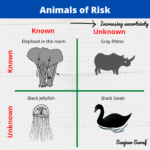Certain chemicals can pose explosion hazards due to their inherent reactivity or interaction with other chemicals or metals. A few years ago the Chemical Safety Board (CSB) had recommended regulating “Reactive Chemicals”. This begs the question – what are reactive chemicals?
At the outset let me tell you that it is not possible to unambiguously define “reactive chemicals”.
Under certain conditions, a chemical can react with itself or its environment resulting in extremely high reaction rates. The high reaction rates can potentially lead to an explosion. Toxic side-products can be produced during the reaction. An example of reactive chemicals is shown in the video below – you will see how hydroxylamine decomposes violently upon addition of metal-salt solution.
I shot the above video with Dr. Liz Cisneros, my colleague at the Mary Kay O’Connor Process Safety Center (MKOPSC)
Can you imagine consequences of the above reaction occurring in closed process vessels? Hydroxylamine was involved in a major explosion at Concept Sciences facility Allentown, PA in 1999.
In the blogs posts that will follow in the future, I will talk about
- how to identify reactive chemicals
- how to characterize reactive chemicals
- choice of risk mitigation measures
- why does reaction lead to explosion
Please join the blog, if you would like to hear from me on this topic.





